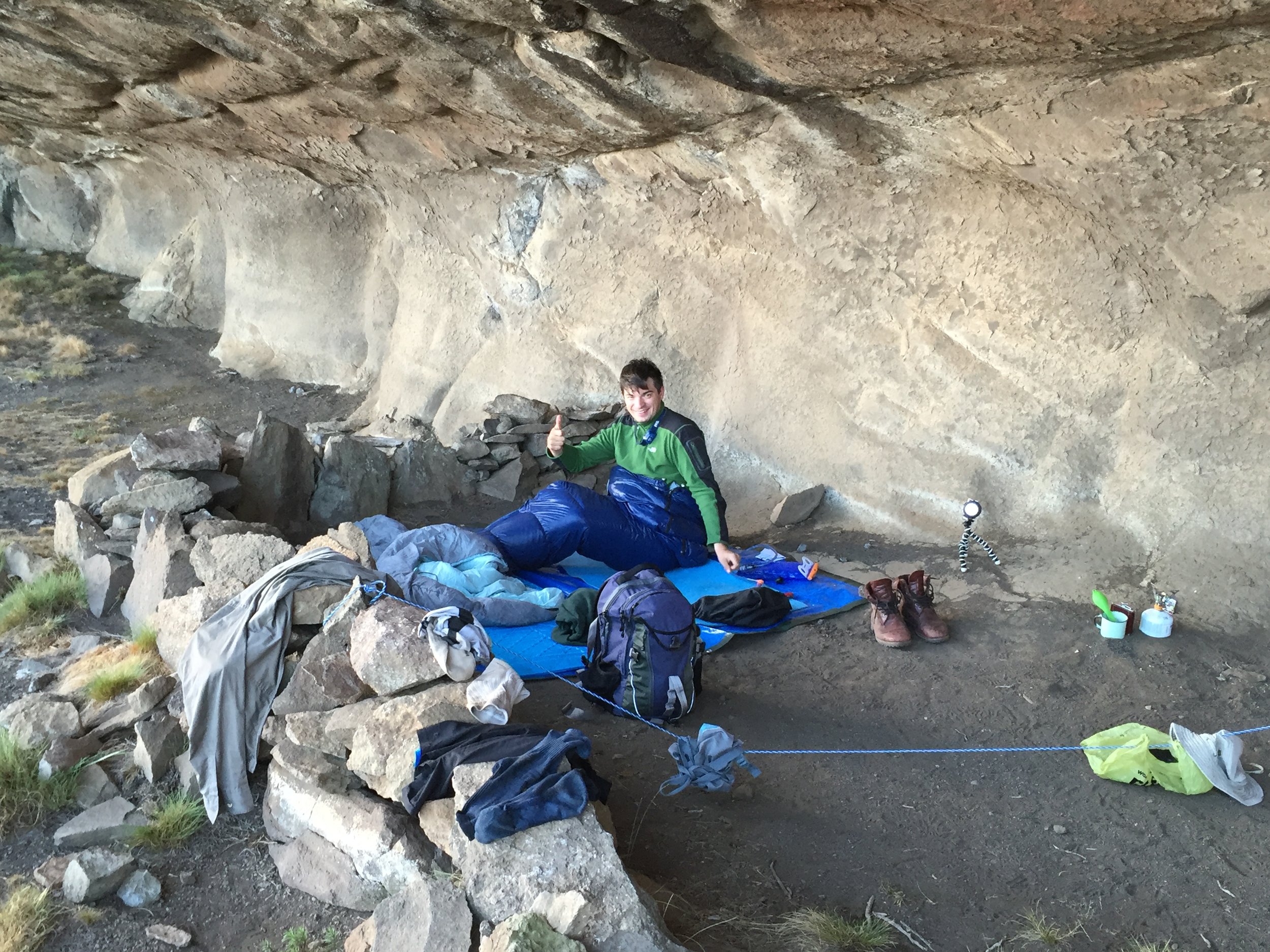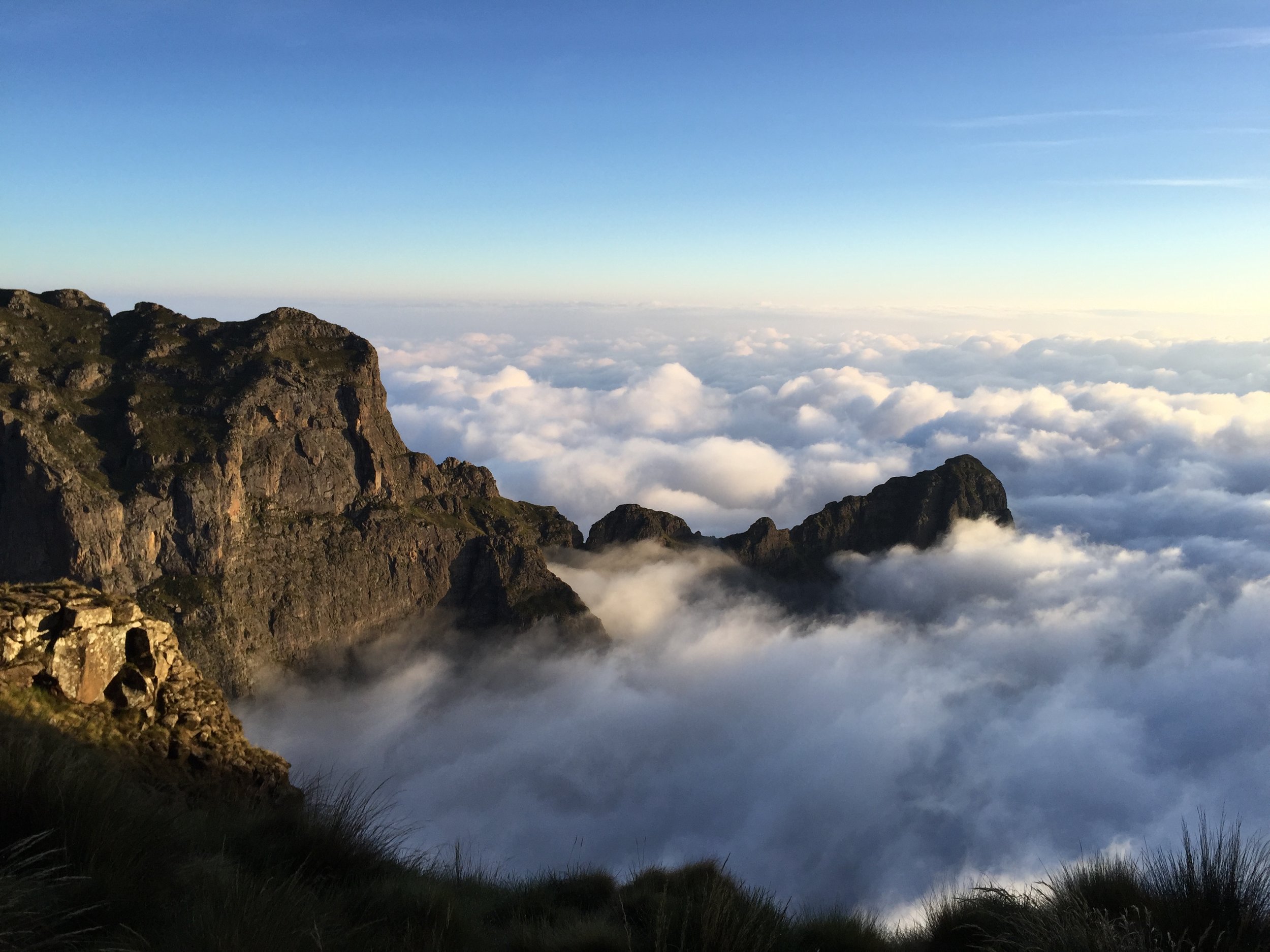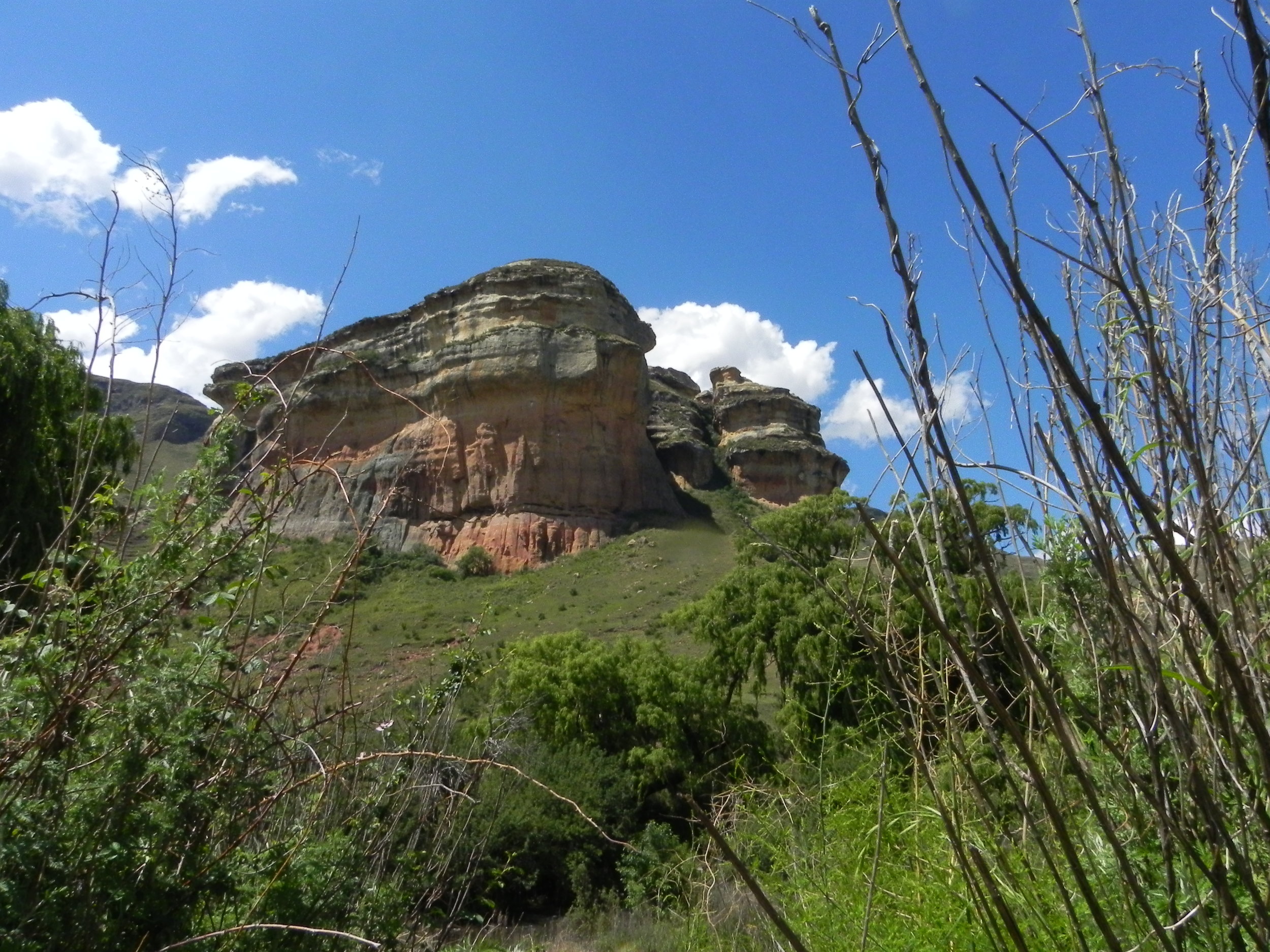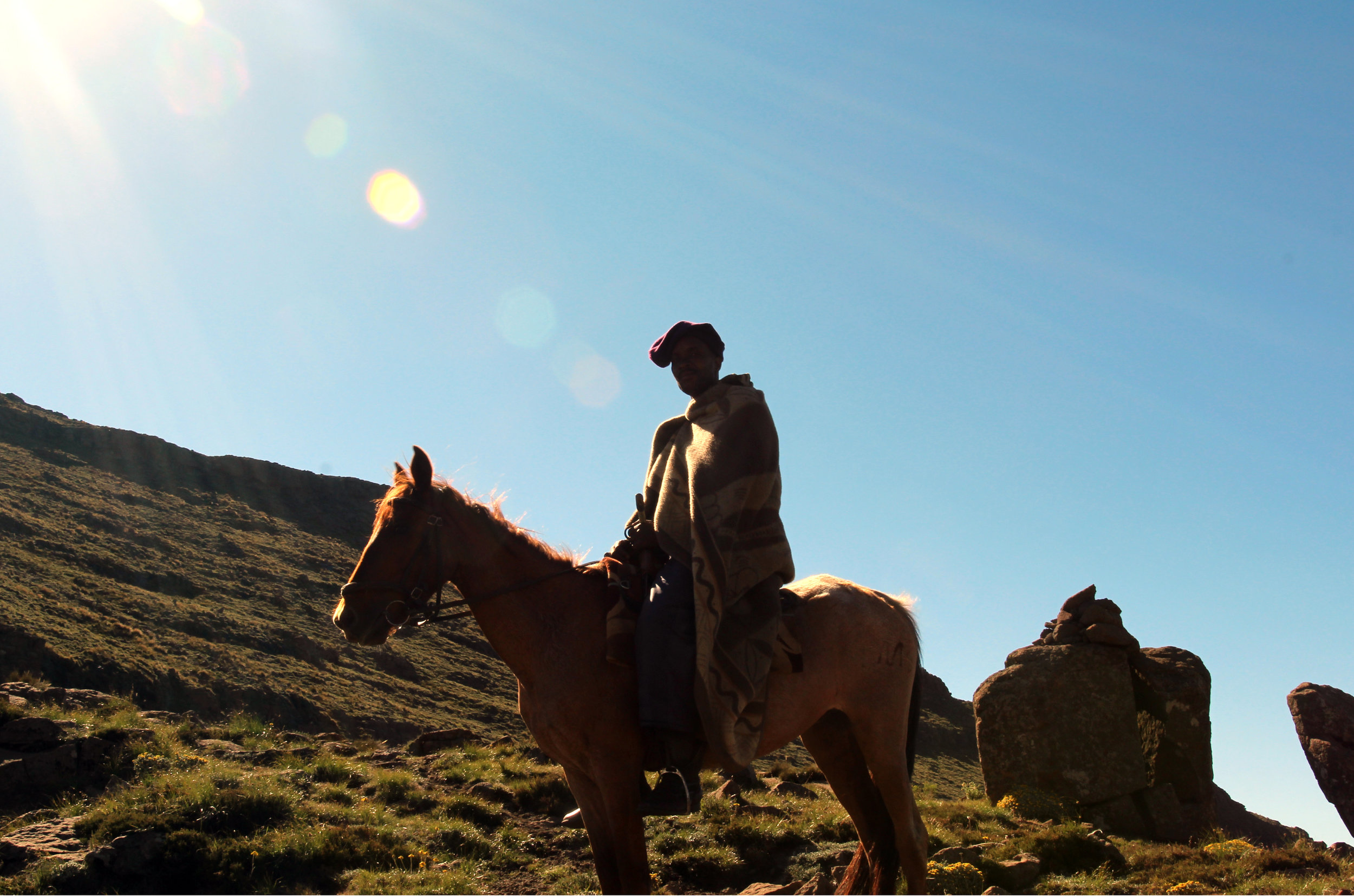How to plan an overnight hike in the Drakensberg mountains
This blog post is a little different from our previous posts. Rather than being about a specific adventure, it is about a place that we hold very close to our hearts: South Africa's Drakensberg mountains. It’s possibly our favourite place in South Africa.
Looking into Lesotho from the top of Giant's Castle Pass
There are two sides to the Drakensberg, the Midlands and the high Drakensberg. In this two-part series, we will describe exploring this mountainous world in Kwa-Zulu Natal, between Johannesburg and Durban. Part 1 will look at how to plan your own hiking adventure into the high Drakensberg and part 2 will look at exploring the Midlands and little Berg in a car and on foot.
Planning a multi-day hike into the Drakensberg can feel intimidating at first. It feels like you need loads of kit, need to be super fit and have lots of hiking experience. We hope this post will show you that it’s more manageable than you think and inspire you.
To reach the high Drakensberg (which are passes that lead up to the Lesotho border) typically requires a day of strenuous hiking. So, before you start planning you need to be fit. Not superhuman, Ironman fit but able to carry a pack and walk uphill for 8 hours (and then sleep in a cave or tent).
When first exploring the idea of hiking in the Berg the first thing that overwhelmed me was the seemingly endless route options. In time, I learnt to embrace this as part of the beauty of the Berg. Because it is such a vast wilderness and there are so many different routes it is unlikely that you will see more than a couple of people while you are out hiking.
The first overnight hike I did was with my dad up the infamous chain ladders, to the top of the Amphitheatre in the Royal Natal National Park and then across to the Ifidi Cave. We drove down from Johannesburg on a Friday after work and stayed at the Witieshoek Mountain Lodge before setting off on our hike early Saturday morning. I learnt a lot on this first hike, mainly about navigation and water.
Buy hiking maps
Above the clouds
The best way to start planning your route is to buy the hiking maps for the Berg. They are available at Maps4Africa in Johannesburg and Takealot. In London, you can buy them at Stanfords. We also use the forum comments on Vertical Endeavour to give us an idea of route conditions and hiking times.
If you can get your hands on a copy of David Bristow’s book, Best Walks of the Drakensberg, that will also help you understand the different routes. There is a fair degree of poetic license in the book (especially around distances and travel times). So, take everything in it with a pinch of salt.
Don’t over commit
Be careful of planning too much driving and hiking in one day. Driving to the Berg from Joburg takes about 4 hours, depending on where you are going. Planning to hike 6 to 8 hours on the same day can be very hard.
The same goes for the way back. If you are Joburg based, the best thing to do is take a half day on a Friday and drive down to the Berg. Stay at the Parks Board accommodation or hike for an hour into the mountains (if you are brave this can be done in the dark). Hike all day on Saturday and then aim to be back at your car by latest 3 pm on Sunday.
Book your cave & pack your tent
When hiking in the Berg you will either sleep in a cave or in a hiking tent on the mountain. Good caves offer fantastic shelter and often mind-blowing views. Detailed information on the condition and shelter offered by the numerous caves can be found on Vertical Endeavor and caves are all marked on the maps. Some caves need to be booked in advanced through Ezemvelo Wildlife.
My advice is to find a cave that you would like to sleep in and then plan your trip around getting to that cave. Always bring a tent - even if you don’t plan on using it – as things may not go to plan. Hikes often take longer than you anticipate or the weather could close in. Caves are few and far between at the top of the escarpment and this is where tents can save you.
Download Gaia GPS
Injisuthi
Hiking in the Berg is not like hiking in Europe or North America, where there are typically well-marked trails and often sign posted. Most hikes in the Berg start on a well-marked trail from an Ezemvelo Parks Board Office, and then as you get deeper into the mountains the paths normally disappear or often lead in multiple different directions, which are not marked on the map.
It’s easy to get lost. Download the Gaia GPS app on your phone. It’s a peer-sourced hiking map. Most of the main routes in the Berg are marked on it. Then visit Vertical Endeavour, a forum with invaluable information on hiking in the Berg. It has GPS routes and waypoints you can download onto the Gaia app. So, you simply have to follow the line marked on the GPS.
Despite the best technology things can go wrong. While doing the Bell Traverse in April this year with two friends I accidentally knelt on my iPhone whilst rummaging around my hiking tent trying to find a head torch. The screen broke and we had no GPS. Fortunately, we had paper maps and a rough idea of where to go. We eventually managed to download the app on one of my hiking partner’s phone when we found cell phone reception. (The friend was from the UK and we used his work phone. He was told he was only allowed to turn data roaming on for emergencies – we thought this counted as one.)
Water, water, water
Giant's castle
Water can often be an issue when hiking in the Berg towards the end of the year, after a long dry winter. On the Ifidi Cave hike, we had to ration our water carefully and still ended up very dehydrated by the end. We went in November, which is at the end of the dry season.
During the Bell Traverse hike, the campsite (marked by a couple of stones in the ground) had no water source. With tents up, I went with one of my hiking partners up the valley in search of water. In the dark, we eventually located a spring in the mountain by listening for water. I have also done hikes in the Berg where there are waterfalls around every corner and you never have to worry about water at all.
Collect water whenever you find it. If you are sleeping in a cave research where the nearest water source is. Make sure you fill up with more than you need and drink what you can when you are at the water source. I don’t purify water in the Berg, as surely it must be some of the cleanest water in the world. I have never had a problem. A Life Straw is a good option if you’re squeamish.
Pack lightly
Indigenous forest at Injisuthi
In terms of kit, there is lots and lots of stuff you can buy for hiking. But travelling as light as possible is one of the most crucial factors for a successful hike. Good hiking boots, a warm jacket and the weather are other important factors. Hiking poles help a great deal also. We use the Outdoor Warehouse hiking checklist when packing for a hike. You can decide what you think is important or not (see the end of this post for a list of resources).
Packing enough food can be a challenge. I try to avoid freeze-dried hiking food - it is lightweight but doesn’t taste great or have that many calories. Pre-made frozen stews are ideal for the first night and then a pasta and sauce for night two works nicely for me.
Take care of yourself
Sadly, there are very infrequent security incidents in the Berg between hikers and semi-nomadic Basotho herdsmen, who live in Lesotho but occasionally they venture down mountain passes into South Africa. This is frequently associated with smuggling.
We have never had any security incidents in the Berg. I have encountered Basotho and they have all been incredibly friendly. The best advice is to check the Vertical Endeavour security incident page, don’t pitch your tent next to major paths at the top of the escarpment or in the middle of mountain passes.
It is essential that you sign in and out of the mountain register at the Parks Board office before and after every hike. Also, tell a family member or friend where you plan to hike and when you expect to return. If you don’t they can raise the alarm.
The raw wilderness, epic views and peace of the Berg make it an extra special place that will forever be in our hearts. I hope you can enjoy it too. Good luck and take lots of photos.
Useful links
Gaia GPS: https://www.gaiagps.com
Info on Berg hiking routes & security: https://www.vertical-endeavour.com/
Hiking checklist: https://www.outdoorwarehouse.co.za/expert-advice/article/hiking-checklist
Buy maps in the UK: http://www.stanfords.co.uk
Order maps: https://www.maps4africa.net/
Book caves: http://www.kznwildlife.com/
Slackpacking & Hiking Trails: http://www.drakensberghikes.co.za/












